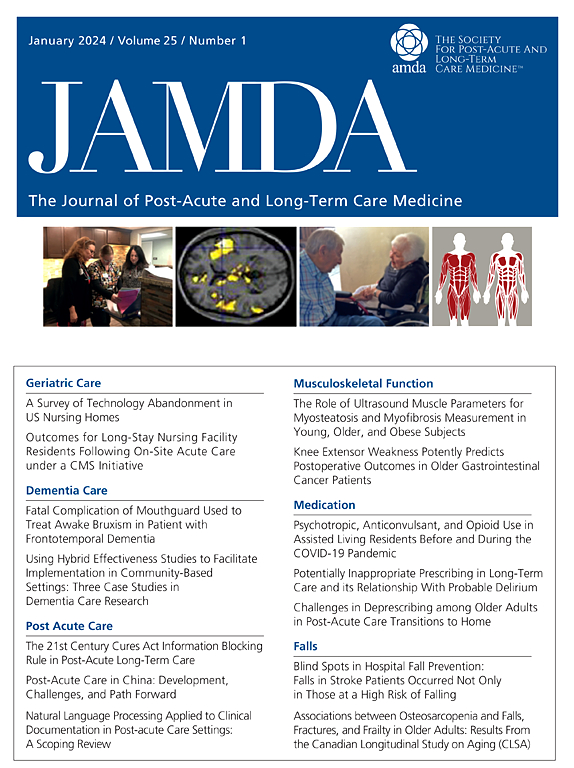辅助生活员工满意度、职业倦怠及DCW工作满意度量表的效度。
IF 4.2
2区 医学
Q2 GERIATRICS & GERONTOLOGY
Journal of the American Medical Directors Association
Pub Date : 2025-07-24
DOI:10.1016/j.jamda.2025.105777
引用次数: 0
摘要
目的:专业护理人员(即直接护理人员)为长期护理居民提供大部分支持。不幸的是,他们的人员流动率一直很高,这与工作满意度低和护理质量下降有关。关于这个话题的大多数研究都是在养老院进行的;本研究探讨了辅助生活服务中员工满意度、职业倦怠、社区和员工特征之间的关系。此外,它评估了直接护理工作者工作满意度量表在这一人群中的有效性,这是对文献的显著贡献。设计:由AL员工和管理人员填写问卷。环境和参与者:来自北卡罗莱纳州68个人工智能社区的559名员工。方法:员工满意度、职业倦怠和人口统计数据。管理员报告了社区特征。计算变量间二元关系的相关性。采用主成分分析法对直接照护员工作满意度量表进行评估。结果:员工满意度为3.05(量表1-4;“满意”),18.5%的人感到筋疲力尽;满意度与倦怠负相关(调整后为-0.43,P < 0.001)。满意度与痴呆患者比例(0.19,P < .001)和提供特殊/记忆护理(0.17,P < .001)呈正相关;与工作人员与住院医师的比例(-0.18,P < .001)和执业护士的存在(-0.27,P < .001)呈负相关。主成分分析得出的单因素解的特征值为10.8,是唯一大于1的特征值。所有量表项目在单因素上加载至少0.70。结论与启示:航空公司员工满意度与职业倦怠呈负相关,近五分之一的员工出现职业倦怠;职业倦怠的程度以前没有报道过,值得注意。协会建议,照顾痴呆症患者可能特别值得,而负责更多的住院医生,与护士一起工作或与更敏锐的住院医生一起工作可能会降低满意度。这些发现可以为人员配置方法提供信息,并对居民福利产生影响。本文章由计算机程序翻译,如有差异,请以英文原文为准。
Staff Satisfaction and Burnout in Assisted Living and Validity of the DCW Job Satisfaction Scale
Objectives
Professional caregivers (ie, direct care workers) provide the majority of support for long-term care residents. Unfortunately, they have consistently high turnover, which is associated with low job satisfaction and decreased care quality. Most research on this topic has been conducted in nursing homes; in contrast, this study investigated relationships between staff satisfaction, burnout, and community and staff characteristics in assisted living (AL). Additionally, it evaluated the validity of the Direct Care Worker Job Satisfaction Scale in this population, a notable contribution to the literature.
Design
Questionnaires completed by AL staff and administrators.
Setting and Participants
559 staff from 68 AL communities in North Carolina.
Methods
Staff reported satisfaction, burnout, and demographics. Administrators reported community characteristics. Correlations were computed for bivariate relationships among variables. The Direct Care Worker Job Satisfaction Scale was evaluated with a principal component analysis.
Results
Staff reported satisfaction of 3.05 (scale 1-4; “satisfied”), and 18.5% were burned out; satisfaction and burnout were negatively correlated (adjusted −0.43, P < .001). Satisfaction was positively associated with the percent of residents with dementia (0.19, P < .001) and provision of special/memory care (0.17, P < .001); it was negatively associated with the staff-to-resident ratio (−0.18, P < .001) and presence of licensed nurses (−0.27, P < .001). Principal component analysis produced a single-factor solution with an eigenvalue of 10.8, the only eigenvalue above 1. All scale items loaded at least 0.70 on the single factor.
Conclusions and Implications
AL staff satisfaction and burnout are negatively associated, and almost one-fifth are burned out; the extent of burnout has not been reported previously and merits attention. Associations suggest caring for individuals with dementia may be particularly rewarding, while being responsible for more residents and working alongside nurses or with higher acuity residents may lessen satisfaction. These findings may inform approaches to staffing and have implications for resident well-being.
求助全文
通过发布文献求助,成功后即可免费获取论文全文。
去求助
来源期刊
CiteScore
11.10
自引率
6.60%
发文量
472
审稿时长
44 days
期刊介绍:
JAMDA, the official journal of AMDA - The Society for Post-Acute and Long-Term Care Medicine, is a leading peer-reviewed publication that offers practical information and research geared towards healthcare professionals in the post-acute and long-term care fields. It is also a valuable resource for policy-makers, organizational leaders, educators, and advocates.
The journal provides essential information for various healthcare professionals such as medical directors, attending physicians, nurses, consultant pharmacists, geriatric psychiatrists, nurse practitioners, physician assistants, physical and occupational therapists, social workers, and others involved in providing, overseeing, and promoting quality

 求助内容:
求助内容: 应助结果提醒方式:
应助结果提醒方式:


